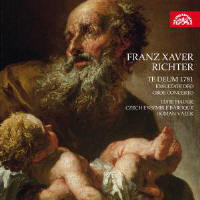Texte paru dans: / Appeared in: |
|
|
Outil de traduction ~ (Très approximatif) |
|
|
Reviewer: Bertil
van Boer
There seems to be a concerted
effort recently on the part of Supraphon and the Czechs to revive interest
in the music of Franz Xaver Richter. As one firmly acquainted with his
symphonies and other music from my own research, this is a trend that I
fully approve, given that he has always been considered alongside Johann
Stamitz as one of the most influential figures of the Classical period. Even
Mozart, visiting him in 1777 in Strasbourg, remarked that he was astounded
at the “fire” contained within his sacred music. Among his achievements can
be reckoned some of the earliest popular symphony editions (from 1744, 12
works performed by the Helsinki Baroque on Naxos), the earliest string
quartets in a set (recorded by the Casal Quartet on Solo Musica), and a huge
number of sacred works (many still unrecorded, alas). A short while ago I
reviewed his oratorio La Deposizione dalla Croce, a work long thought lost
but which turned up in the former East German archives. (I have a long story
to tell about this, but here is not the place.) Now the Czech Ensemble
Baroque has issued its third disc, this one devoted to his rather expansive
Te Deum from 1781. Written when he was 72 years old, this work reflects both
a lifetime of compositional activity, as well as a thorough familiarity with
the genre.
As expected, the opening
chorus is infused with the brilliance of the high brass, but the second
movement, a duet for the soprano and tenor, is quite virtuoso with the first
using all of the vocal tricks at her disposal, while the tenor sneaks in to
fill out the lower harmony. Here Richter uses a pair of high horns to lend a
sparkle to the operatic duet. The next aria, Tu Rex gloriæ, for alto solo
has a huge introduction that would not be out of place in a brilliant
concert aria. The solemn dotted rhythms of the Te ergo quæsumus then give
way to another operatic movement, this time for the tenor. Here we are
firmly in the concert hall, with lots of virtuoso display. Even more
brilliant is the Dignare Domine, in which the bass voice is paired off
against the clear tone of the trumpets and timpani. All that is left is the
final fugue, In te Domine speravi. As Richter was a master of counterpoint
one can expect a nicely developed bit of counterpoint, and here there is no
disappointment. In keeping with the aesthetic of the time, however, there
are more than their share of bright homophonic episodes, and the entire
piece ends with a powerful flourish. Given that it is only a bit over 20 minutes in length, the disc has to be filled out in some fashion. The ensemble has chosen a pair of instrumental works and a short motet Exultate Deo. One of the former is the lively and brilliant D-Major Symphony, with high-flying trumpets and a powerful energy in the outer movements. Probably written for the Mannheim orchestra, it doesn’t exactly conform to their standards, for it doesn’t rely upon their clichés or devices, but rather proceeds on its own course. It is written for a pair of war trumpets, or at least that is what the Regensburg source states, and the bright fanfares seem to indicate that it is a festive work with military connections. The second instrumental work is the Oboe Concerto in F Major. Richter was no slouch when it came to the concerto, but this piece seems like it dates from early on in his career. The opening ritornello, for instance, has all of the trademarks of the galant style, with rhythmic juxtapositions and clear motivic themes. The solo part is actually quite sedate but idiomatic for the instrument. The opening part still has some sequences that harken back to the Baroque, but the melody both flows and has enough roulades to require some expertise on the part of the performer. The Andante begins with a forceful unison, resolving to a plaintive solo line beneath which the accompaniment provides an implacable unison. The final Vivace is a rollicking minuet that trips right along joyously. The motet, one of four composed for the Feast of Corpus Christi, is vibrant and powerful with swirling trumpet and timpani fanfares and a decisive homophonic choral part that lends a continual brilliance to the short work. This is interrupted by solo voices with an obbligato and quite militaristic timpani fanfare. This is militant Christianity in music. As for the performance, the Czech Baroque Ensemble is suitably bright a clear in their tone, spot on pitch, and conductor Roman Válek keeps his tempos hopping. The voices of the leading singers are also precise and finely attuned to the style of Richter’s often challenging parts. Oboist Luise Haugk has a bright tone, and she performs the various ornaments with ease. This is one excellent disc and should be a part of any collection of Classical-period work. Here’s to more Richter to come. | |
|
|
|
|
Cliquez l'un ou l'autre
bouton pour découvrir bien d'autres critiques de CD |
|




